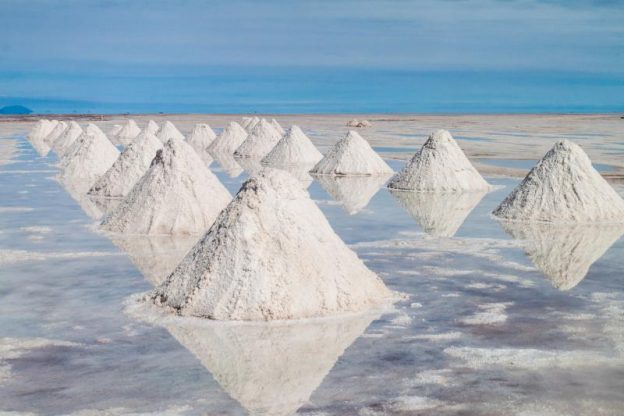Lithium is one of the most important metals of the 21st century. It makes possible the rechargeable battery technology found in mobile phones, laptops, and electric vehicles. But where does lithium actually come from?
There are two main sources of lithium: mines and brine water. Most of the world’s lithium (87 percent) comes from the latter source. Among brine water sources, briny lakes (known as salars) offer the highest concentration of lithium (1,000 to 3,000 parts per million). The salars with the highest lithium concentrations are located in Bolivia, Argentina, and Chile.

Brine extracting of lithium.
Lithium obtained from salars is recovered in the form of lithium carbonate, the raw material used in lithium ion batteries. The production process is fairly straightforward and requires only natural evaporation, which leaves behind not only lithium, but also magnesium, calcium, sodium, and potassium.
The lithium content of ocean water is far lower, hovering around 0.17 parts per million. However, about 20 percent of the lithium in seawater can be recovered using a combination of membranes, filters, and ion-exchange resins.
Brine mining is normally a lengthy process that takes anywhere from eight months to three years. But scientists are working to develop technology that can extract lithium and other valuable materials – including gold, zinc, copper, and silica – from the brine water used by geothermal power plants. Collecting lithium from geothermal brine could make the whole lithium production process far faster and cheaper than the natural evaporation processes that are normally used.
In 2010, for instance, Simbol Materials received a $3 million grant from the U.S. Department of Energy to develop just such a technology. Simbol adapted technology originally developed by Lawrence Livermore National Laboratory to create a series of filters and adsorption materials that can capture lithium and other materials in the brine water pumped out of the ground by geothermal plants to generate energy. After removing the lithium and other materials, the water is sent back to the geothermal plant for re-injection below ground.
New technology has also opened up the possibility of recovering oilfield brine, the briny water that bubbles up when oil wells are being drilled. Last year, for instance, MGX Minerals developed a method for extracting over 83 percent of the lithium in oilfield brine.
But even using traditional recovery methods, extracting lithium from brine is easier and cheaper than hard-rock mining by about half.
The remaining 13 percent of the world’s lithium is found in more traditional mines. Lithium concentrations in hard rock (pegmatites) are higher than those found in brine, but the mining process has a higher cost and a larger environmental footprint. Still, hard-rock lithium mining can be competitive, at least in mines that are already in operation.
Over 145 minerals contain lithium, but only five (spodumene, lepidolite, petalite, amblygonite, and eucryptite) are utilized in lithium extraction. Of those five, spodumene provides the largest proportion of all mineral-derived lithium. In 2011, spodumene yielded 12,500 tons of lithium, while the other sources provided only about 1,500 tons.
After spodumene is mined, it’s heated to 1100°C, then cooled to 65°C and ground up, mixed, and roasted with concentrated sulfuric acid. The sulfuric acid kicks off a reaction in which lithium sulfate replaces hydrogen. The slurry is then filtered and a number of additional compounds are added. After its pH level is adjusted, the mixture is concentrated through evaporation. Finally, soda ash is added to create lithium carbonate.
The smallest currently available source of lithium is that contained in recycled electronics. While lithium recycling is not yet capable of yielding lithium pure enough for reuse in batteries, it can be used in glass and ceramics, the second-largest lithium-consuming industry after the lithium ion battery industry. But lithium recycling remains a niche market, and only one recycling facility for lithium ion batteries exists in the U.S.
In the future, hectorite clay deposits could provide a significant source of lithium. Procuring the clay itself would be easy, but it would need to be leached or roasted in order to extract the lithium. Clay has not yet been exploited as a source of lithium, but analysts say that for American manufacturing purposes, mining lithium-rich clay in Nevada could be almost as cost-effective as importing it from Chile.
Whether the lithium mining industry turns toward clay, oilfield brine, or some other recovery method, it’s clear that the rapid increase in lithium consumption over the past few decades requires an equal expansion of lithium sources and production sites. In 2009, the lithium ion battery industry accounted for 21 percent of all annual lithium consumption. Today, that figure has almost doubled, and battery production – especially batteries for the manufacture of electric vehicles – will continue to gobble up a progressively larger share of lithium. A single electric vehicle requires as much lithium as 10,000 mobile phones, and global electric vehicle sales will essentially double in 2021, then double again by 2025. In other words, expanding access to lithium must remain a priority for the EV and electronics industry.
A more diverse lithium supply could also help break up the oligopoly that currently controls the trade. Today, just four companies (Chile’s SQM, U.S.-based FMC Corp and Albemarle Corp, and Australia’s Talison) produce 85 percent of all lithium.
Finally, expanding lithium mining operations could insulate lithium prices against potential shocks. For instance, if Chile (which holds over half of all the world’s known lithium reserves) was destabilized, prices would spike dramatically, as they did in China a few years ago when an Australian spodumene shortage led to a 300 percent price increase. Price increases like these could threaten the entire lithium ion battery industry – and the sustainable energy future along with it.


Be the first to post a comment.